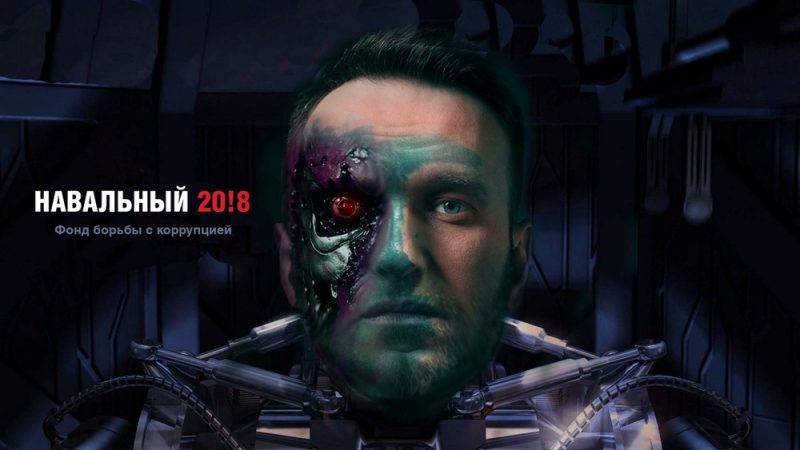
Source: Alexei Navalny, Twitter
Days after opposition leader and presidential candidate Alexei Navalny was again doused with green antiseptic on his way to an event in Moscow, the news website Gazeta.ru reported that the Kremlin had instructed regional authorities to crack down such attacks in the future.
Gazeta.ru quoted a source in the Kremlin as saying that attacks on Navalny and other oppositioners with “brilliant green” antiseptic—known as “zelyonka” in Russian—are giving the opposition free press and helping to raise its profile across the country. “In fact, attacks are only increasing their popularity.” Law enforcement authorities will be encouraged to crack down on the attacks and punish perpetrators, the source said.

A campaign ad for Alexei Navalny
Navalny was hospitalized on Thursday after an attacker poured zelyonka on him outside his office in Moscow. On Sunday, he wrote on his website that he is still treating his right eye, which was sprayed during the attack, and that he is worried that he may lose some vision.
Zelyonka attacks have become so frequent in recent months that bright green has become the unofficial color of Navalny's 2018 presidential campaign and the broader anti-Putin opposition. Navalny's supporters have painted their faces green in solidarity and tried to use the attacks as a way to mobilize volunteers.
According to one of Gazeta.ru's sources, a recent attack on the popular blogger Ilya Varlamov in the southern city of Stavropol on April 26 was the “last straw.” In the days since the attack, law enforcement authorities have rounded up five attackers—though Varlamov says that ten people were involved.
Всем привет pic.twitter.com/tyUNBzatQV
— Илья Варламов (@varlamov) April 26, 2017
Hey, everyone!
Still, the attacks don't appear to be slowing down. Yesterday, the popular blogger Tema Izgagin was attacked by men in the city of Samara.
Yesterday in Yekaterinburg, some thugs followed @itema_Tv after he left an anti-Putin protest, cornered him, & sprayed him with antiseptic. pic.twitter.com/Cnyg5jbKpb
— Kevin Rothrock (@KevinRothrock) April 30, 2017
Navalny wrote on his blog on Sunday that the Kremlin was behind the attacks on him, an accusation one of Gazeta.ru's sources flatly denied. Gazeta.ru's report calls into question the notion that the attackers are acting on instructions from local or regional authorities, however. In particular, one source called attention to the fact that many of the perpetrators who have been identified come from regions neighboring where they carry out the attacks, suggesting that they are centrally coordinated.
Another source, meanwhile, said he believed the attackers were acting independently and out of a sincere belief that Navalny and other members of the opposition are harmful to the state.
В Администрации президента не знают кто плеснул зеленкой Навальному в глаза pic.twitter.com/r4J5Capz24
— Roman Dobrokhotov (@Dobrokhotov) April 30, 2017
The Presidential Administration has no idea who sprayed green antiseptic in Navalny's eyes.
The Kremlin's concern that the attacks are raising the opposition's profile comes amidst a surge in Navalny's popularity: nearly 100,000 volunteers have signed up to work on Navalny's presidential campaign, suggesting that his political movement may be more popular than many initially thought.
Party Membership:
United #Russia: ~2 mln
Communists ~150K
LDPR ~180K
Just Russia ~410K
Yabloko: ~50KRegistered @navalny volunteers: ~95K
— Fabian Burkhardt (@fa_burkhardt) April 30, 2017
And indeed, Navalny's anti-corruption message seems to have increasing purchase with Russians. On March 26, tens of thousands people joined nationwide anti-corruption protests organized by Navalny, the largest anti-government demonstrations in Russia since 2011-12.








1 comment
Putin plays dirty. He plays gangster style